Overnight New York Style Bagels
These bagels are chewy, crusty and properly dense New York Style Bagels. The overnight rise creates the perfect texture and flavor – and you’ll have fresh, hot bagels for breakfast or brunch less than an hour after getting out of bed.
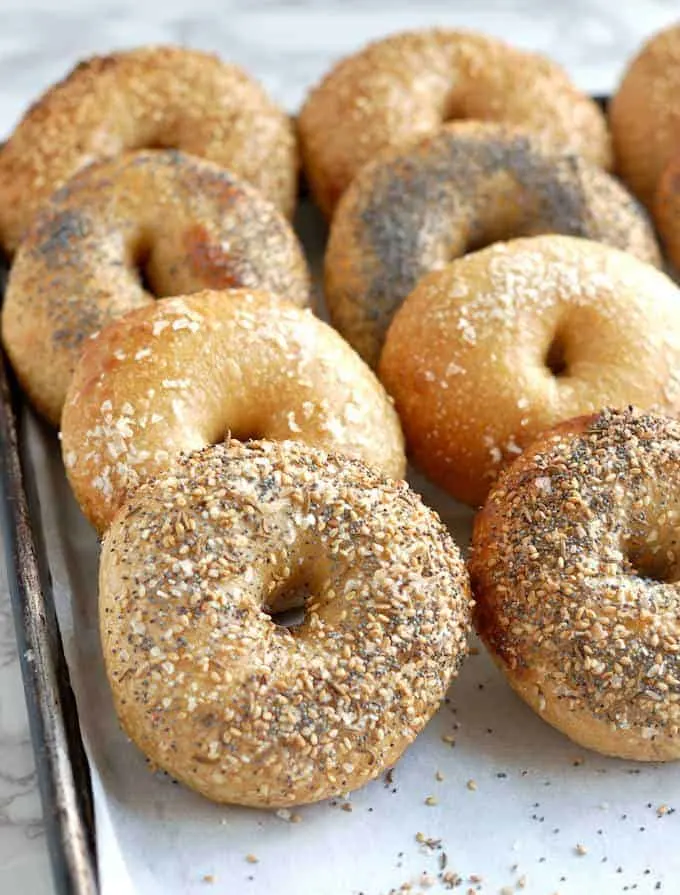
What is a true New York Style Bagel?
I promise you if you follow this recipe correctly you can make a good bagel at home. I mean, there are loads of really bad bagels in the world and life is just too short to eat a bad bagel.
Like a really great loaf of Rye Bread there’s nothing like a true New York style bagel.
A good New York Style Bagel (really, is there any other kind?) must have a nicely dense and chewy texture with a toothsome crust.
To get that characteristic chewiness we’ve got to develop some really strong gluten in the dough.
If you love baking bread and want to understand the process a little better, take a look at comprehensive Bread Baking Guide. It covers the basics of mixing, kneading, proofing, and baking so you can get perfect results every time.
If you’ve got a sourdough starter, you can make Homemade Sourdough Bagels .
Ingredients
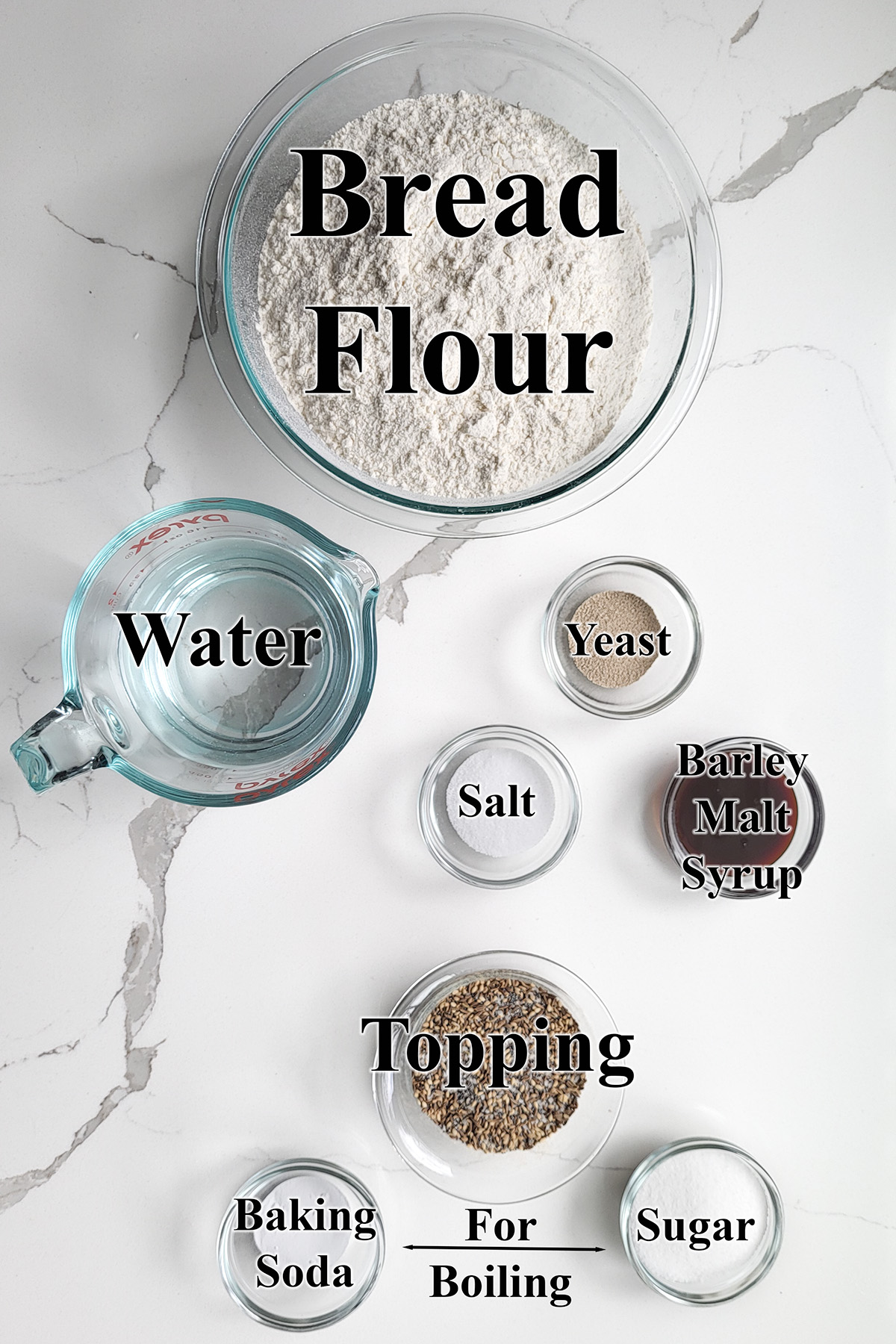
Ingredient Notes
- Bread Flour – Bagels should have a very chewy crumb from a strong gluten network in the dough. High protein bread flour develops plenty of gluten.
- Yeast – I prefer instant yeast to rapid rise yeast for a slightly slower rise. A slow overnight rise gives more time for flavor to develop.
- Barley Malt Syrup – Adds a traditional slightly sweet note to the dough. You can substitute honey or a combination or honey and molasses for the barley malt syrup.
- Toppings – Leave the bagels plain or use your favorite seed for topping. You can mix seeds with salt to make your own “everything” bagel topping”. See the recipe card for details.
- Baking Soda & Sugar – For boiling the bagels. The boiling process creates the specific shiny and chewy bagel crust.
How to make New York style Bagels
See the recipe card for detailed measurements and instructions.
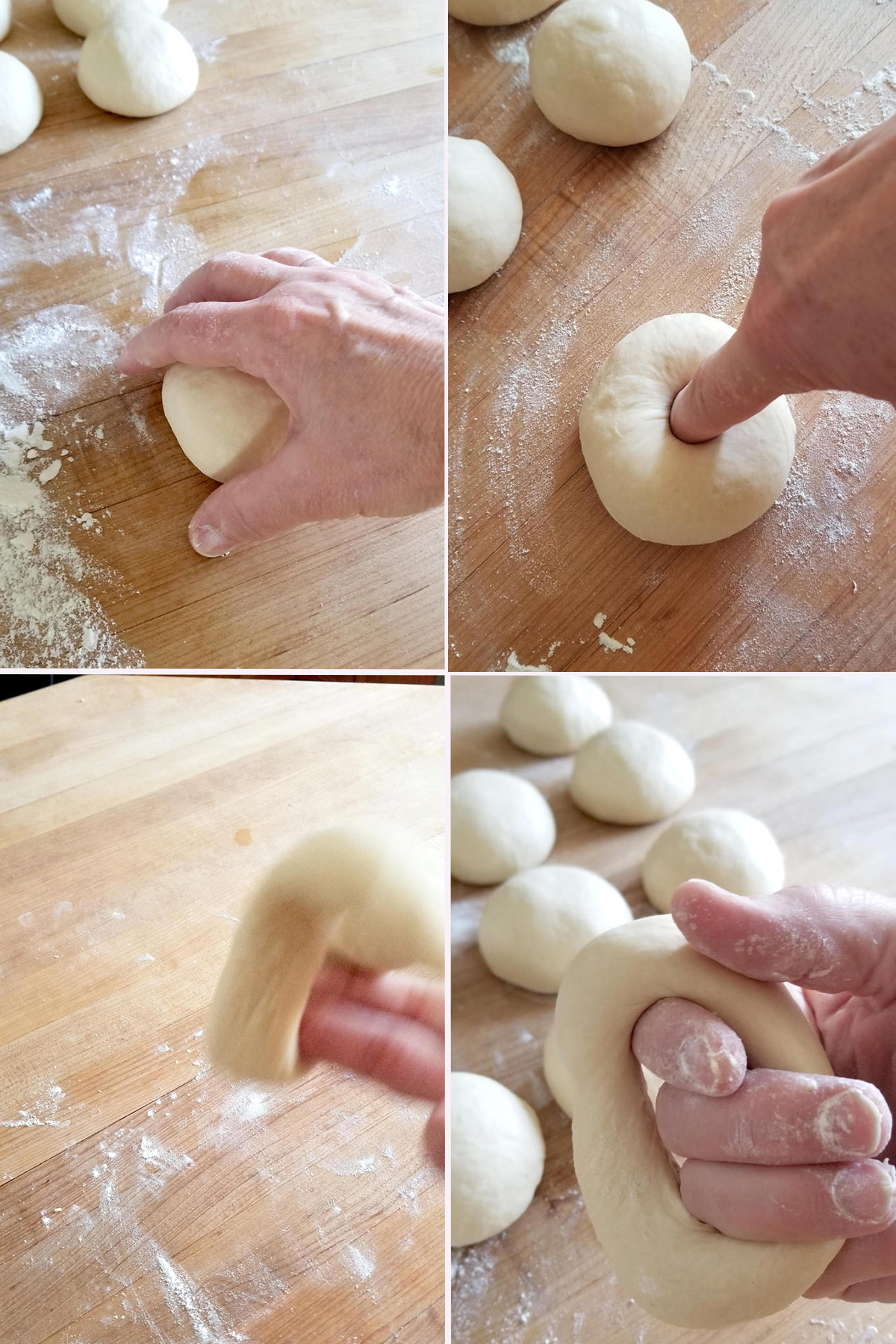
- Use a cupped hand to form the a piece of dough into a smooth ball.
- Poke your finger all the way through the center of the ball to make a hole.
- Twirl the dough around your fingers to widen the center hole.
- Set the bagel onto the baking sheet and continue with the rest of the dough.
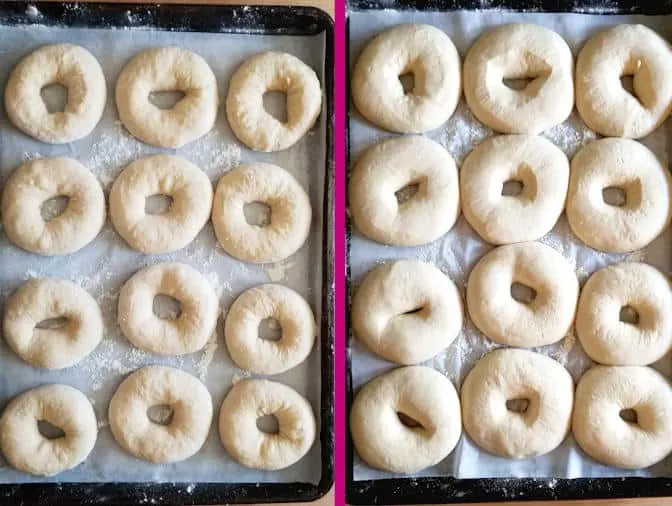
- Cover the pan and place the bagels in the refrigerator overnight.
- If you want to make the bagels the same day set them aside at room temperature for 1 hour.
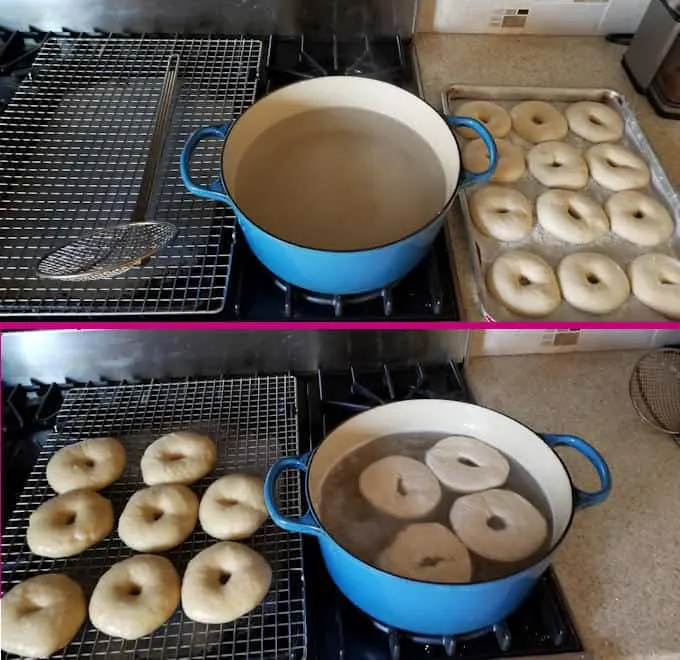
- Bring a pot of water with baking soda and sugar to a boil. Preheat the oven.
- Boil the bagels a few at a time, flipping them every thirty seconds. Boil each batch for 2 minutes.
- Transfer the bagels to a rack to drain while you finish boiling the rest of the bagels.
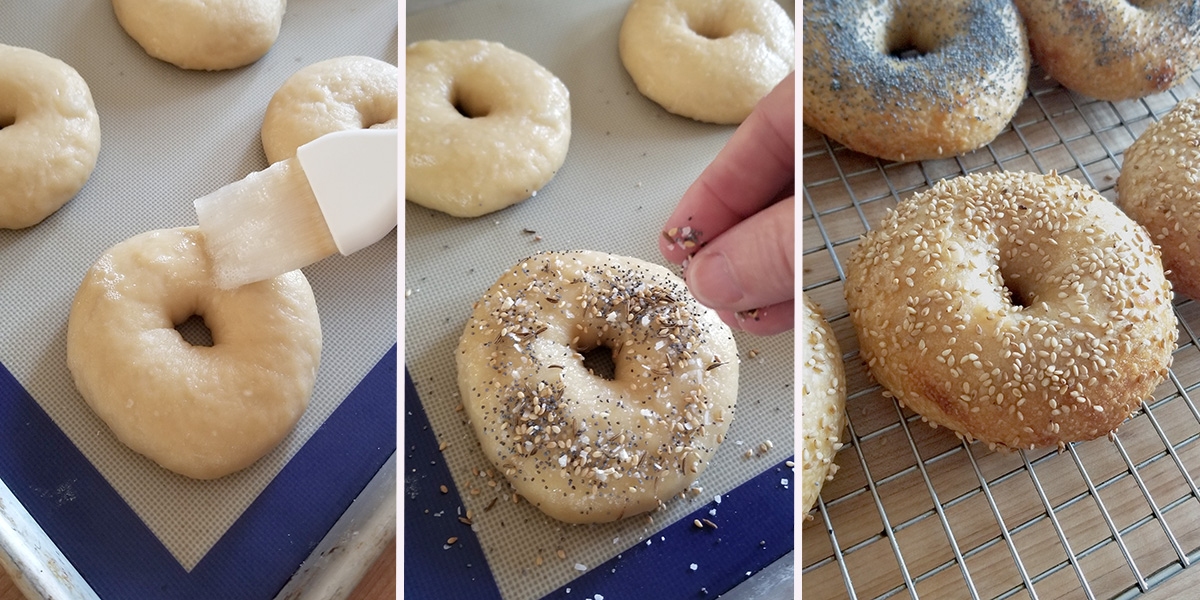
- Brush the boiled bagels with egg white.
- Sprinkle seeds or bagel topping if desired.
- Bake until the bagels are golden brown.
Recipe Tips
- Allow the sponge to rest for 30 minutes before mixing the dough. During that rest the water has time to hydrate the flour and gives us a head start on gluten develop.
- To make the bagels the same day, skip the overnight rise in the refrigerator.
- Bagels are best the day they are baked. For longer term storage slice the bagels about 3/4 the way through and pack them into freezer bags.
- Previously frozen bagels are best if toasted before serving.

You might also like to try these Cinnamon Raisin Bagels.
If you love this recipe as much as I do, I’d really appreciate a star rating and a quick comment. Ratings and comments help my recipes show in search results. Thanks!
Overnight Bagel Recipe
Ingredients
- 16 oz warm water (2 cups (about 100°F))
- ¼ oz instant yeast (2 ¼ teaspoons)
- 25 oz bread flour (5 cups, divided, see note)
- 1 ½ oz barley malt syrup ( 2 tablespoons, see note)
- 1 tablespoon table salt
- 2 oz granulated sugar (¼ cup (for boiling))
- 2 teaspoons baking soda (for boiling)
- 1 egg white (whisked lightly)
- Topping (Sesame seeds, poppy seeds, caraway seeds or coarse sea salt)
Instructions
- In a bowl for a stand mixer or a large mixing bowl combine 16 oz warm water, ¼ oz instant yeast and 3 cups (15 oz) of the flour . Mix to form a thick batter. Cover the bowl and set aside for 30-60 minutes.
- Add 1 ½ oz barley malt syrup and 1 tablespoon table salt. If using a stand mixer, switch to the dough hook. Add the remaining flour and mix to combine. Knead 5 minutes on medium/low speed. If working by hand, stir in as much of the flour as you can, then turn the dough out onto a lightly floured surface and knead in the remaining flour. Knead 5 minutes. Form the dough into a smooth ball.
- Put the dough into a lightly oiled bowl, turning once to coat the dough. Cover the bowl and set aside to rise until doubled in size, about 1 hour.
- Line a half sheet pan with parchment paper lightly sprinkled with flour or sprinkle the pan generously with cornmeal. Turn the dough out onto a lightly floured surface and knead briefly. Divide the dough into 10 even pieces. Use a cupped hand to roll each piece into a smooth, tight ball.
- To form a bagel, poke your finger all the way through the center of a ball to make a hole. Use two fingers to gently widen the hole. Continue gently stretching to form the bagel or twirl the dough around your fingers to widen the center hole (see photos). The hole should be 1 – 1 ½" wide.
- Place the bagel on the prepared sheet pan and continue to form the remaining bagels. The dough will probably spring back a bit so you can go back and re-stretch them once you're done forming all the bagels. Cover the pan with lighly oiled plastic wrap and leave at room temperature for 15 minutes then place the pan in the refrigerator overnight.
- In the morning, take the pan out of the refrigerator. The bagels should be noticeably fuller. Leave the tray out until the bagels come to room temperature, about 1 – 1 ½ hours. The time will vary based on the temperature in the room and how much the dough rose in the refrigerator. Once the dough comes to room temperature the bagels are ready to boil.
- Meanwhile, preheat the oven to 450 °F. In a large pot combine 1 gallon of water with 2 oz granulated sugar and 2 teaspoons baking soda and bring it to a boil. Reduce the heat to keep the water at a rolling simmer. Set a cooling rack over a clean sheet pan and place it next to the stove.
- Lift a bagel off the sheet pan and lower it into the boiling water, bottom side down. Depending on the size of your pot, you can boil 3-4 bagels at a time. Boil the bagels for 30 seconds then flip them. Boil the other side for 30 seconds. Repeat the process again for a total of 2 minutes boiling time. Remove the boiled bagels from the water and set them on the cooling rack to drain.
- Line two half-sheet pans with parchment paper or silicone baking mats and generously sprinkle with cornmeal (or flour). Place 5 of the boiled bagels on each sheet pan. You could fit them all on one pan but they may rise enough to stick together as they bake. I like all the sides to be crusty so I leave plenty of room between them.
- Brush the bagels with egg white. You can leave the bagels plain or add the topping of your choice. To make "everything" bagels combine a tablespoon of each of sesame seeds, poppy seeds & salt with a 1/8 teaspoon garlic powder and onion powder. Adjust toppings to your taste.
- Bake until golden brown, about 20 minutes.
Would you like to save this recipe?
As an Amazon Associate and member of other affiliate programs, I earn from qualifying purchases.









Hello! In Brooklyn and self isolating, but really craving a bagel. Can whole wheat flour be substituted in?
Do you only have whole wheat flour? Do you have any all purpose or bread flour? Whole wheat flour doesn’t develop the gluten as well as white flour does. A dough made with just whole wheat is generally quite heavy.
Can’t get my hands on any bread flour – seems everybody’s cooped up inside and baking. I do have all-purpose, can I substitute that?
I accidentally used half all purpose flour the other day before I realized what I was doing. The bagels were still good. I think you’ll make pretty good bagels even with all ap flour. Just make sure to give the dough a good 5 minutes of kneading to really develop the gluten. Also, bread flour will absorb a little more liquid so if the dough is really sticky knead in a couple more tablespoons of flour.
Thank you so much! Planning to use all-purpose and will report back.
This was the first dough recipe I ever made and they came out wonderfully. I substituted the malt for 1tb of brown sugar, and it worked quite well. One thing I learned is that the cross-section of the bagel is important – if it’s not completely round, tougher flat spots will happen while the rest of the bagel rises. Still, it’s delicious. Some stores sell “everything” seasoning. I used this and it was super easy. It’s also great for other foods!
One question – is allowing these to rise in the fridge for longer than 12 hours okay?
Yes, I’ve left them in the refrigerator as long as 16 hours.
I’m planning to make a batch from this recipe tomorrow, but I’m already stumped at the ingredient list! My preference is to measure ingredients in grams whenever possible, so I was glad to see measurements in both volume and mass units on your site. Alas, I can’t make sense of your flour measurements. According to the King Arthur Bread Flour (which you mentioned using in another comment) packaging, 1/4 cup is equivalent to 30g, so 1 cup would equal 120g, and 5 cups equal 600g (or 21.25 oz). Your recipe calls for “5 cups (25 oz. 700g)”. Can you clarify which measure you use/suggest given the disparity?
Thanks for your guidance!
Because I’m based in the US where most home bakers tend to use volume measure, that’s how I start most of my recipes. Because I use the “dip & sweep” method for measuring flour I get 5 oz per cup of bread flour. So that is my base measure for my recipes. I use the conversion of 28g per ounce. So 5 oz x 28 = 140g per cup. 140g x 5 cups = 700g. If you divide 700g/5 cups then by 4 that equals 35g per quarter cup. Not a huge difference. A total of 25g in the whole recipe, or less than 1 ounce. If you are following my recipe I suggest you use my measurements since that is how the recipe was created.
OMG these bagels turned out amazing, even when I subbed one of the ingredients. The recipe calls for 42g of Barley Malt Syrup, I only have Diastatic – Malt Powder, so I decided to experiment. I used the same 42g of the diastatic malt instead. Left the bagels covered in the fridge over night, followed all the instructions the same, and the bagels turned out amazing! Nice crisp crust, soft inside. LOVE this recipe! I’m definitely ordering your book on Amazon!!! Thank you for this great recipe! 😉
Oh, thanks Loly!I like the substitution of diastatic Milk Powder for the malt syrup. Glad you liked the recipe. If you maintain a sourdough starter, I highly recommend the Sourdough Bagel recipe. I’m also currently working on a Sourdough Bialy recipe.
Any suggestions for helping the bagels not stick to the parchment paper aside from sprinkling with flour? My bagels had a good rise and shape to the them this morning, but when I tried to pick up my first bagel to put in the boiling water, it did not want to come off the parchment paper very easily, stuck to my fingers as I transported it to the water, and deflated. They rose back a tiny bit in the oven, but overall very deflated after good success shaping them and rising overnight in the fridge 🙁
Someone else mentioned that they use a silicone bagel mold. I haven’t used it so can’t speak from personal experience. I just make sure to sprinkle a very even layer of flour over the tray. If you miss spots that’s where the dough can stick. I haven’t tried placing the bagels on a silicone baking mat, but I might try it next time to see how it works. You could also try brushing a thin layer of oil over the paper instead of flour.
Thank you so much for your suggestions, I will try them out next time!
I use cornmeal. It makes all the difference! No sticking at all.
Yes. I’ve also been using cornmeal and did update the recipe to include that information.
If I may make a comment, I cut the parchment between bagels when ready to boil and individually turn the paper with the bagel upside down. So I never touch the bagel and have less chance of deflating it.
Yes, that works well.